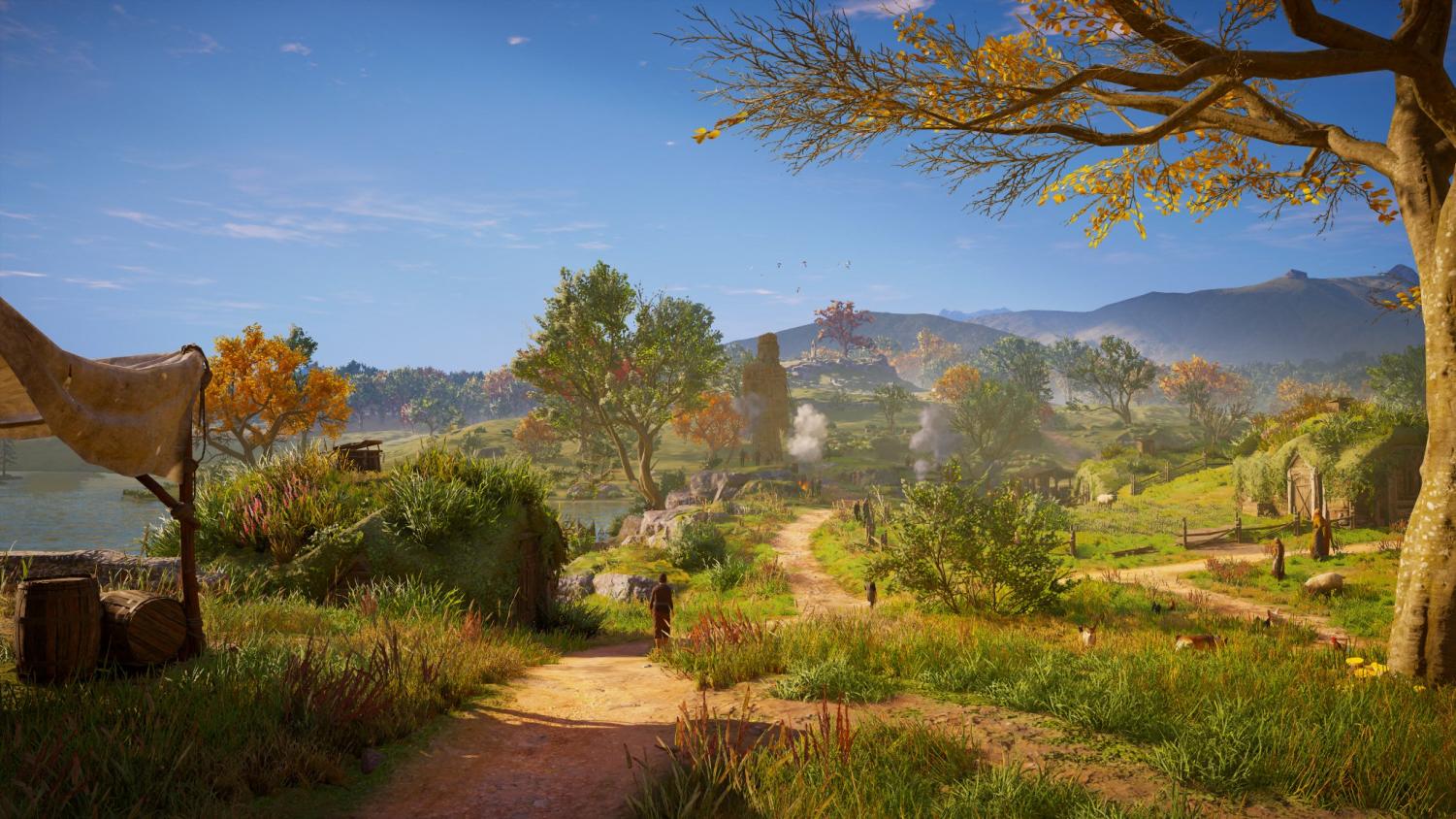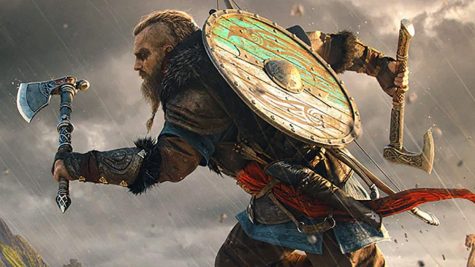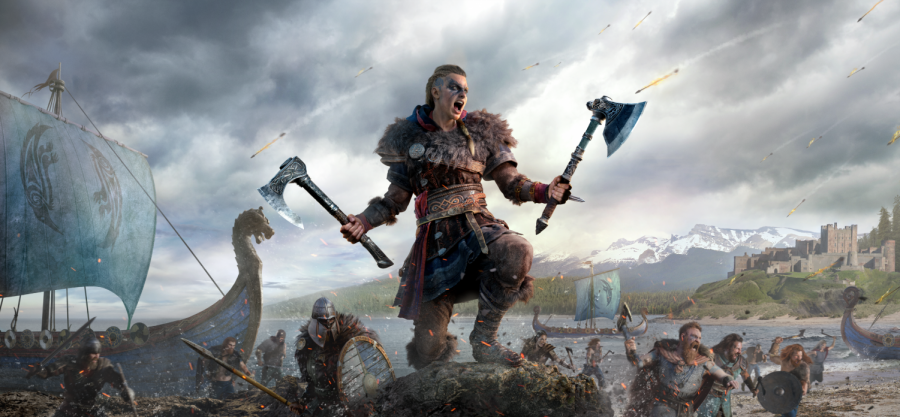Wonderful, inspired and imaginative: an “Assassin’s Creed Valhalla” review
December 3, 2020
Vikings aren’t known for their subtlety. In fact, Vikings tend to be known for brutally raiding and pillaging their way across Europe. Despite the series’ nominal focus on a secret group of assassins, Ubisoft puts players into the shoes of one such Norse Viking and sends them off to pillage and raid their way across much of England in “Assassin’s Creed Valhalla.”
Interwoven Sagas

Narratively, “Assassin’s Creed Valhalla” follows a Viking named Eivor, decided by the player as male or female, as they journey first through Norway to avenge their father’s death with the character’s older brother Sigurd, then to establish a new kingdom called Ravensthorpe in England.
Once in England, Eivor is sent out to establish alliances between Ravensthorpe and the various territorial rulers who run things. Set in the late 9th century, wood-roofed viking longhouses, straw-thatched huts and massive stone-walled towns and castles abound across the two lands.
In England, the story progresses territory by territory. Each territory has issues that need to be settled in order to gain each ruler’s allegiance. One territory is run by a king who needs overthrowing, another territory is at war and needs peace established and yet another involves finding killers who assassinated a territory’s ruler.
These individual storylines break up the monotony that would normally come with a long story, but most importantly, they’re a ton of fun. Forging connections with people feels good, especially when they trust Eivor enough to pledge open support to Ravensthorpe.
The heart of the overarching storyline though is Eivor and Sigurd’s relationship. It’s a testament to the writing in “Assassin’s Creed Valhalla” that the stresses and trials of Eivor and Sigurd’s relationship still hit home, even as the overarching story progresses sporadically. Throughout the story, players making choices as Eivor affects this relationship and as a result, the story’s ending.
Best of all though, “Assassin’s Creed Valhalla” leans into Norse myth in creative and wonderful ways. Throughout the game, mythological figures like Thor, Odin and the Norns are referenced shortly into the game, in casual conversations throughout and even some ways that don’t become clear until the final credits roll.
Across the Realms

Instead of a single, massive open world for players to explore, Ubisoft has crafted three smaller, yet still hefty lands to explore.
Norway is a freezing, brutal land of icy rivers and looming, towering snow-capped cliffs. Getting around Norway means scaling mountainsides, trudging through snow and sailing along rivers and coasts. The freezing waters that cut through the Norse landscape will actually hurt players who fall into them, while the sheer mountain walls bordering valleys give the impression that the giants of Norse legend might’ve actually walked these lands.
England on the other hand, is dappled with verdant hillsides, autumnal woodlands and dank reed-filled marshes. Ancient Roman ruins rise up and dot the English landscape while roads cross over hills and valleys, connecting small villages and walled cities alike. The various territories that make up England all have their own feel to them. In the heart of Lunden (London), centuries old Roman buildings sit alongside fragile looking wooden constructs while the River Thames flows through its center. Grantebridgescire, another region in England, has large swaths of marshland, where tiny bits of land rise up out of the water, populated by stunted trees, jagged stumps, quick bursts of flowers and marshy reeds.
In stark contrast, Vinland sits on the wild, untamed east coast of North America. The steep hill and mountain sides are filled with tall fir and spruce trees, while turkeys, squirrels and deer roam through the trees and brush. While Vinland is much smaller than England, it’s full of different sights, sounds and things to do.
Roaming through England, Norway and Vinland, there are all sorts of hidden treasures to loot and ancient artifacts to pillage. New weapons and armor, including a couple mythically-inspired pieces of gear can be looted from ancient ruins across Norway and England, while hunting animals and ore deposits provides the materials to upgrade weapons and armor.
The real color of these worlds though, comes from the people who populate it. Walking through towns, down roads or through meadows, there will be characters with issues the player can help with. Unlike traditional side quests, these interactions are often short and filled with bits of humanity. One side quest involves helping a warrior process his grief over losing his family and comrades, while another involves hurling an old man’s belongings off a cliff and still another involves simply lending an ear and a helpful word to an old sailor.
Aside from the looting, exploration and side quests, there are also hallucinogens to take, drinking contests to compete in and Middle Age rap battles to win. It’s this sheer variety of things to do that make the worlds of “Assassin’s Creed Valhalla” so enjoyable. Instead of repeating the same few tasks for every NPC, each one feels unique and individual.
Finally, there are several secret areas to explore and discover that are genuinely some of the most fun and inspired parts of this game. These areas are so wonderful, inspired and imaginative that they almost feel like they deserve games of their own.
Raiding Coast & Shore

In “Assassin’s Creed Valhalla,” the most effective way of exploring is by longship, following the rivers through 9th century England. While on the rivers, players can raid unsuspecting targets.
Nowhere with concentrations of wealth and resources is safe from the Raven Clan’s raiders. Particular targets include villages, military encampments and the monasteries and churches scattered around England’s coasts and rivers.
Raids start in one of two ways, the first way is to sneak ashore alone to scope out the target and lower the defenses before blowing a war horn to call in the band of raiders. The more direct approach, however, is to initiate a raid by blowing the war horn while on the longship, running the boat up on to the beach and charging straight at the guards side-by-side with fellow raiders.
While each raiding location is unique in its own way, they begin to become repetitive after the initial few. The raids tend to stick with the same formula of storm the beach, take out the guards, burn and pillage the buildings for supplies, then leave. However, some of the destinations are in vastly different locations which makes the raids feel new and refreshing with the beauty of the different landscape.
The raids, while not required, are a key component in upgrading the clans settlement. The Raven clan settles in a land they go on to call Ravensthorpe. The settlements start off small with just tents and the members who left Norway. As time progresses, and the Raven Clans reputation builds, more and more people come to join the settlement bringing their own specialties and shops. In order to expand the settlement and get better bonuses from settlers, the tents need to be upgraded into buildings which cost supplies and raw materials. Supplies can be found in a lot of places around England in chests. Raw materials however, are only obtainable through raids.
Steps From Greatness

Like its’ two most recent predecessors, most of “Assassin’s Creed: Valhalla” comes down to fighting, exploring and talking.
Fighting in “Valhalla” means either silently picking off enemies from the shadows or brutally eliminating them in open combat. While stealth takedowns tend to be relatively clean, relying on bows from a distance or a dagger up-close, open combat is extremely violent and tends to see various enemy body parts severed, crushed or impaled by whatever the player’s weapon of choice happens to be. Best of all though, fighting is a ton of fun. Parrying enemy attacks feels amazing. Almost as amazing as a final boot to their face which usually follows. Don’t misunderstand, stealth works perfectly well, but the joy of controlling a Viking lies in using axes and broadswords to separate limbs from their owners.
How much trouble enemies give you depends on how powerful they are compared to the player. Unfortunately, it’s super easy to stumble into extremely difficult areas early in the game with no warnings. In fact, one of the territories bordering Ravensthorpe has enemies that can kill the player almost instantly. Stumbling into those areas while trying to explore is a right pain, since they feel gated off for no actual purpose other than to direct players.
Exploring the sizable worlds of “Assassin’s Creed Valhalla” is a generally entertaining trek with beautiful vistas to enjoy and tons of smaller locations to discover, investigate and loot along the way. Riding along roads on horseback or sailing a longship down rivers is faster than walking. Plus they come with auto-pilot and cinematic camera angles that make for beautiful journeys along specific pathways.

Trekking along on foot is much more enjoyable though. Jogging along the natural environments are gorgeous, but most importantly, it’s easy to search out or stumble upon interesting side quests, lootable locations and gorgeous sites that just aren’t visible from the road.
Investigating interesting locations generally takes a bit of effort, but with a bit of searching, it’s easy to discover breakable walls or hidden passages that lead to treasure. Unfortunately, some locations can be incredibly obtuse to break into.
Climbing and moving around the various walls, fences, columns and other bits of architecture, both in big cities and in the wilds, can be annoyingly fiddly sometimes. Most of the time, moving and climbing works perfectly well, but the occasional unintended jump to a different piece of architecture can spoil stealthy approaches or force a redo on a bit of platforming.
Finally, while much of the story of “Assassin’s Creed Valhalla” is set, the player can affect the course of the story through dialogue and actions. For instance, choosing to be truthful with a certain character early on can spare the player from troublesome bounty hunters throughout the rest of the game, while certain conflicts can be avoided by passing speech checks. Choosing to spare or save characters, choosing to invest time into improving skills or spending time to collect possible evidence surrounding a mystery, can all have repercussions throughout the course of “Assassin’s Creed Valhalla.”
Canoes over Canada

While most of “Assassin’s Creed Valhalla” works well, there are a few bugs and odd creative choices that hold it from its full potential. In terms of bugs, “Assassin’s Creed Valhalla” tends to work pretty well, but there are some notable exceptions.
Walking through Vinland, canoes spawned up in the air over bodies of water on occasion. For quests, there were a couple times where people who needed to be spoken to for quests couldn’t be spoken to. The only fix was to either leave the area and come back or to reload the save. There were also a few instances where NPCs wouldn’t move when they were supposed to either lead the player somewhere or follow the player somewhere.
There are also a few odd creative choices that bring down the overall experience. One particular choice is the excessively gory assassination confirmations, which feel more like a “Mortal Kombat” fatality than anything else in “Assassin’s Creed Valhalla.”
Occasionally, an autosave will happen right before running into massively powerful enemies. Meaning, when the powerful enemy predictably defeats the player, the player restarts right in front of the enemy, forcing the player to run away from an enemy who can catch up if the player isn’t careful.

Despite the bugs and negative oddities of “Assassin’s Creed Valhalla,” there are also some wonderful unique quirks.
The best of these positive quirks is that players can pet the dogs that hang around Ravensthorpe. A close second is that if players collect all the requisite gear, they can obtain and wield Thor’s hammer.
Also, Danish Composer Jesper Kyd’s return to the “Assassin’s Creed” franchise could not have come at a better time. Joined by American composer Sarah Schachner and Norweigan composer Einar Selvik, they and Kyd formed an excellent soundtrack to listen to while fighting throughout England, Norway and Vinland as 9th century Vikings.
Final Thoughts
Dominic’s Score: 8.5/10 (PS4)
“Assassin’s Creed Valhalla” is a beautiful, brutal trip across Norway, England and Vinland. The mythical tint and area-by-area approach to its’ story keeps things interesting, while a wide, wild variety of side quests infuse the world with humanity. Despite a few irritating quirks and a few odd bugs, “Assassin’s Creed Valhalla” is a game worth playing.
Ryan’s Score: 9/10 (PC)
“Assassin’s Creed Valhalla” is an excellent addition to the Assassin’s Creed franchise. While England is not a new location for the Assassins, the 9th century setting makes it feel completely different from other settings. The story stays interesting almost entirely throughout the campaign with very few, if any, missions feeling repetitive and tedious. Despite a couple of crashes and a few release day bugs, “Assassin’s Creed Valhalla” is a phenomenal game.
This game was reviewed by Ryan Bough and Dominic D’Amico, playing on a PC and PS4, respectively. Game codes for this review were provided by Ubisoft.










